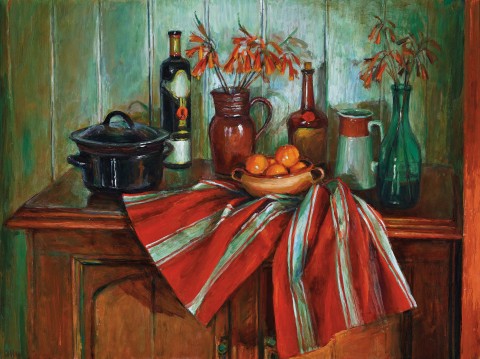KITCHEN CUPBOARD AND CHRISTMAS BELLS, c.1981
MARGARET OLLEY
oil on composition board
76.0 x 101.5 cm
signed lower left: OLLEY
bears inscription with title on frame verso: KITCHEN CUPBOARD AND CHRISTMAS BELLS / 12
Philip Bacon Galleries, Brisbane
Private collection, Brisbane, acquired from the above in 1981
Margaret Olley, Philip Bacon Galleries, Brisbane, 11 September 1981, cat. 12 (illus. in exhibition catalogue, as 'Kitchen Cupboard with Christmas Bells')
‘The art of Margaret Olley is the art of deliberate choices. The same could be said of Olley herself, who dispels all theories of Australia's isolation, repression of women and fashion following… she persists in painting that which is around her; one reason for this is loathing of pretence, of adopting ways of thinking that are not true to the reality of self.’1
Unswayed by changing fashions and the tide of late Modernism, Margaret Olley was forever steadfastly devoted to the humble still life. As observed by her dear friend and former director of the Art Gallery of New South Wales, Edmund Capon, ‘still-lifes and interiors are her métier, and Margaret Olley is a part of that tradition, from Vermeer in the seventeenth century to Morandi in the twentieth century – two of her most admired artists – which finds inspiration, beauty and a rich spirit of humanity in the most familiar of subject matter.’2
Painted just prior to the artist’s departure for a sojourn to Asia, United States and the United Kingdom in 1981 (during which she eagerly attended exhibitions of her artistic mentors Henri Matisse and Giorgio Morandi), Kitchen Cupboard and Christmas Bells, c.1981 is a superb example of Olley’s masterful manipulation of light and space. Featuring the distinctive red and yellow native flowers in a stoneware jug, balanced alongside various wine bottles, a ceramic stove pot and bowl of mandarins atop the rustic wooden kitchen cupboard, the composition is deliberately nonchalant, with the fruit bowl casually resting upon the folded red and white striped cloth as if the artist had just placed the items there only moments before. However, this ambience conceals a carefully considered orchestration of space. Arranged and rearranged like props in a theatre set, the objects in Olley’s paintings were meticulously placed and, in time, became as acquainted to viewers as they were to the artist herself. The double-handled earthenware fruit bowl, green glass vase, jug and striped tablecloth are all recurring ‘characters’ on her stage, imbued with the stories and memories of her colourful life. As Barry Pearce elucidates in the catalogue accompanying the artist’s retrospective at the Art Gallery of New South Wales in 1996, there is more to Olley’s paintings than a mere still-life – we are invited into her personal domain: ‘Darkness and light, fertility and decay, space and time, tragedy and comedy, solitude, camaraderie; all the things we know and imagine about life and humanity can be gathered at her table within the rooms of her world.’3
1. France, C., Margaret Olley, Craftsman House, 2002, p. 13
2. Capon, E., quoted in Pearce, B., Margaret Olley, The Art Gallery of New South Wales, Sydney, 1996, p. 7
3. Pearce, B., Margaret Olley, Art Gallery of New South Wales, Sydney, 1996, p. 21
